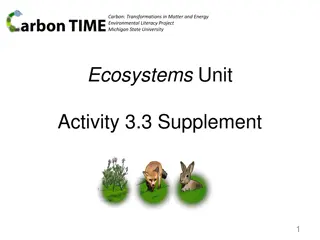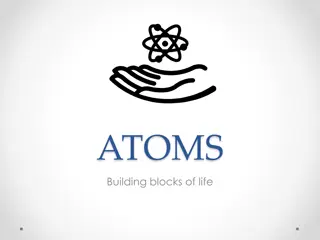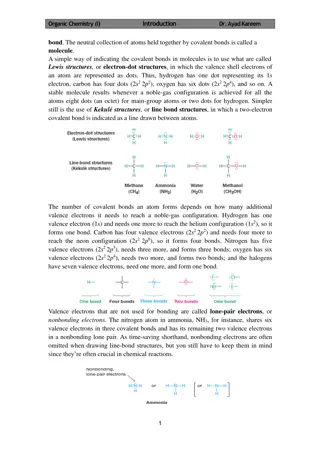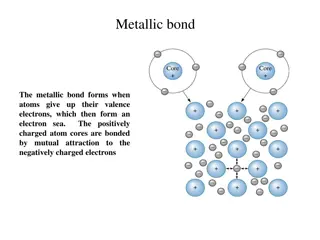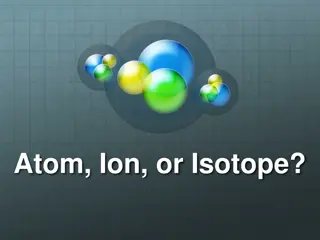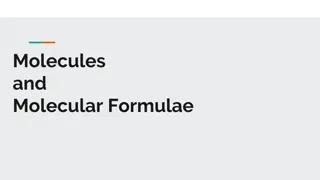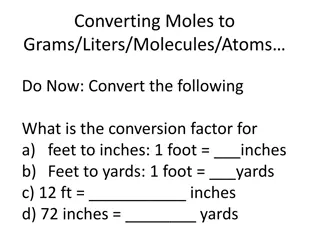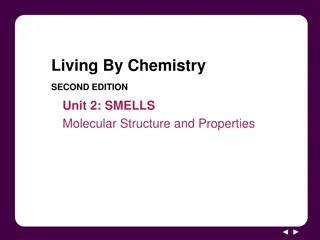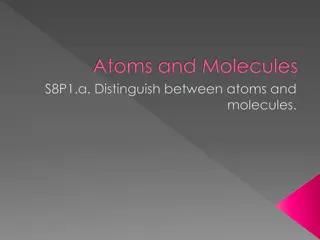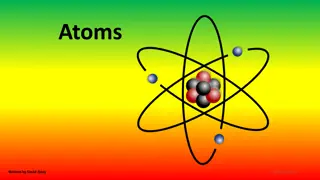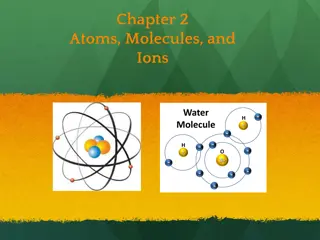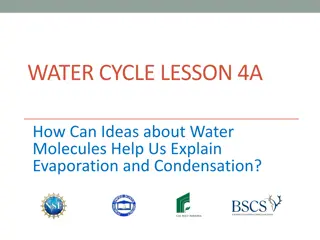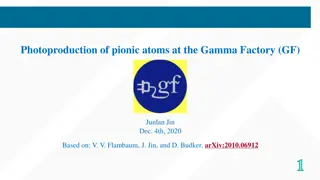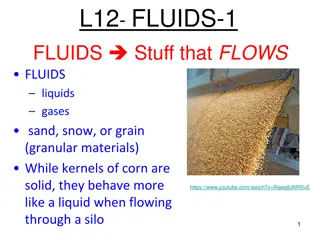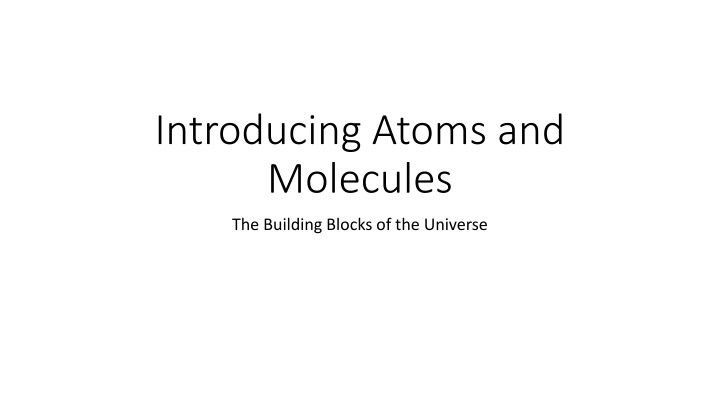
Exploring Atoms and Molecules as the Foundation of the Universe
Discover the intriguing world of atoms and molecules, the fundamental building blocks of the universe. Dive into the history of how these tiny entities were conceptualized, learn about their composition, and understand their significance in forming compounds. Explore how atoms come together to create everything around us and delve into the fascinating realm of the periodic table.
Download Presentation

Please find below an Image/Link to download the presentation.
The content on the website is provided AS IS for your information and personal use only. It may not be sold, licensed, or shared on other websites without obtaining consent from the author. If you encounter any issues during the download, it is possible that the publisher has removed the file from their server.
You are allowed to download the files provided on this website for personal or commercial use, subject to the condition that they are used lawfully. All files are the property of their respective owners.
The content on the website is provided AS IS for your information and personal use only. It may not be sold, licensed, or shared on other websites without obtaining consent from the author.
E N D
Presentation Transcript
Introducing Atoms and Molecules The Building Blocks of the Universe
The image you might see when the word Atom is mentioned is likely to be the Science Fiction favourite type The real atom is much more complicated, but this idea of electrons flying round the nucleus like the planets going round the sun works quite well. We call this a model and there are several, each one is used when the circumstances call for it. Sometimes we just use a small ball, or sphere
So how did it get to be called an Atom ? Why not call it Fred or Jim ? Around 400 BC a Greek philosopher named DEMOCRITUS stated that everything was made up of these little, indivisible entities, they are always moving around and between each one there is nothing but empty space. DEMOCRITUS said that if you cut an object in half, then cut one of the halves in half, and keep cutting The Greek word for indivisible is .. ATOMOS you would eventually get to a point where you could not cut any more, what you were left with was indivisible
ATOMS What are they made of? With the exception of the simplest atom (Hydrogen), atoms are made of: Protons Neutrons Electrons These carry a positive charge (+1) and weigh 1.6726 x 10-27 Kg These carry NO charge (0) and weigh 1.6749 x 10-27 Kg These carry a negative charge (-1) and weigh 9.1 x 10-31 Kg
Because PROTONS have a +1 charge, the more of them we have in an atom, the more charged the atom will become. But . Scientists KNOW that Atoms are NOT charged (normally) they are Electrically Neutral so where have all the +1 s gone? Well . The ELECTRONS as we know have -1 charges, so if the atom is NEUTRAL, what is this telling us? (discuss) +6 +5 +4 +3 +2 +1 0
We now know that there are smaller parts to the Atom, such as Protons and Neutrons, and even smaller parts inside Protons, but we don t need to worry about those just yet. There is an expression in Science: It s the protons that give an atom (element) its identity, but it s the electrons that give it character! Atoms join together to make compounds, and everything you see around you (including yourself) is made up of atoms and compounds. There are 92 naturally occurring atoms, but scientists have artificially forced some atoms together to make new ones, although some of them don t last much more than a few billionths of a second, they exist and have got names. Many years ago, a scientist called Dmitri Mendeleev studied the known atoms, and put them into a table, grouping them by the way they behaved (their properties ). This table was called The Periodic Table .
Here is the modern Periodic Table of the Elements (you might see this as PTE):
We need to look at a few definitions now, so that everything makes sense: 1. ALL matter is made up of ATOMS 2. An ELEMENT is a substance which is made up of only ONE type of ATOM 3. The number of PROTONS in the NUCLEUS is what identifies the ATOM/ELEMENT 4. The number of ELECTRONS is the SAME as the number of PROTONS in an ATOM 5. The number of PROTONS is known as the PROTON NUMBER, or ATOMIC NUMBER 6. The number of NEUTRONS in an ATOM determines the ISOTOPE of the ELEMENT 7. The number of PROTONS and NEUTRONS in an ATOM added gives the MASS NUMBER The MASS NUMBER is RARELY a whole number because of ISOTOPES. If it is shown as a whole number it is usually in [ ] because we don t have enough data to work it out more precisely.
Exercise: 12 C What is this element s name? CARBON 6 What is this element s atomic number? What is this element s mass number? 12 6 How many protons does carbon have? 6 How many electrons does carbon have? 6 How many neutrons does carbon have? 6 (in this example anyway, but can vary) MASS NUMBER ATOMIC NUMBER How did I work out the last answer?
ATOMS join together to make COMPOUNDS A COMPOUND is a substance that contains two or more different elements, joined together chemically (they are said to be bonded ) Compounds can often be broken down into the elements that they are made of, but this takes chemical reactions to do it, and can be quite complicated. ATOMS can also make MIXTURES A MIXTURE is a substance that contains two or more different elements, mixed together, they are NOT bonded and can usually be separated quite easily by one of a number of methods (we ll see these later).
Exercise: I have some sand and some water, I put them in the same beaker and stir it up. Have I got a compound of sand and water or a mixture? This is a mixture, not a compound because sand won t react with water. We can separate these by filtering out the sand through a filter paper. I have a tablespoon of salt, and I dissolve it in water. Is this a compound now, or a mixture? It s still a mixture, although it dissolved, it didn t chemically react so we could use evaporation to get the salt back if we wanted to. I have a strip of magnesium metal and burn it in a Bunsen burner flame, it turns into a white powder called Magnesium Oxide. Is this a compound or a mixture? When Magnesium burns in air, it chemically reacts with Oxygen to make Magnesium Oxide. This is a COMPOUND and can t easily be separated back into the elements
So . What is a MOLECULE ? A molecule is made of two or more atoms of the same OR different elements, chemically bonded by sharing electrons This is a model of a molecule of CHLORINE, a poisonous gas and its atoms always go around in pairs. They are joined together by sharing TWO electrons. This is called a single bond and it is VERY strong.
So . What is a MOLECULE ? A molecule is made of two or more atoms of the same OR different elements, chemically bonded by sharing electrons This is a model of a molecule of OXYGEN, a gas which we need to breathe and its atoms always go around in pairs. They are joined together by sharing FOUR electrons. This is called a double bond and it is VERY strong.
So . What is a MOLECULE ? A molecule is made of two or more atoms of the same OR different elements, chemically bonded by sharing electrons This is a model of a molecule of NITROGEN, a gas which makes up 78% of our atmosphere and its atoms always go around in pairs. They are joined together by sharing SIX electrons. This is called a triple bond and it is VERY strong.
So . What is a MOLECULE ? A molecule is made of two or more atoms of the same OR different elements, chemically bonded by sharing electrons Finally . this is a model of a molecule of CARBON DIOXIDE, a gas which we breathe out and is one of the gases responsible for global warming. The carbon atom borrows electrons from each oxygen, and they borrow electrons from the carbon. Two double bonds form and this makes a very stable molecule.
Exercise: Chlorine Oxygen Nitrogen Carbon Dioxide

